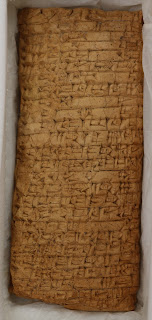Nowadays, visitors to the Baths enjoy their chance to walk upon
the stone trodden by Roman feet two thousand years ago; but did you know that,
in the 1960s & ‘70s, there were regular events which gave people an even
more intimate taste of ancient culture, allowing them to dine at a full Roman
banquet around the baths themselves?
An invitation to the very first of these, in
the shape of a scroll with a wax seal and ribbon and entitled LUDI SULIS I JUNIUS MCMLXI (The Games of
Sulis, 1st June 1961), has recently been acquired by the Roman Baths:
 |
| The invitation to the Roman banquet |
The invitation sets out full details of the ‘orgy’, from
clothing and music to décor and food, interspersed with quotes from poets such
as Tibullus and Propertius, and even begins with a specially-composed,
three-verse Latin poem, inviting the guests to the feast:
 |
| The invitation’s heading, including the Latin invitatory poem |
The first two verses imagine the invitee as a weary ploughman
or shepherd, enticed to take rest under a tree, sate their thirst and be lulled
to sleep. The final verse invites the guest to a rather less tranquil affair,
as can be seen by a possible translation:
But if you prefer a ladle of Falernian wine with water, or an beautiful girl to a disgusting sheep, seize the lavish joys of the night with the orgies of Sulis.
Every invitee was required to attend in full Roman attire to
make the atmosphere more authentic, the men therefore being given a purple toga on arrival, the women a stola (a long, sleeveless dress). Together
with the invitation was a photograph (see below) showing some guests in their
outfits. The women’s hair is arranged in Roman style, in accordance with the
invitation’s suggestion that they ‘imitated Cypassis’, an ‘expert
in ornamenting hair in a thousand fashions’ (ponendis in mille modos perfecta capillis,
Ovid Amores II.8).
 |
| Guests to Ludi Sulis in their Roman attire of toga or stola |
Each item of food in the gustatio
(hors d’oeuvres), fercula (roast)
and mensa secunda (dessert) was an
authentic Roman delicacy. These ranged from tunny fish, snails, honey cakes and
stuffed pastry birds to a complete roast pig, which greeted the guests as they
arrived to sit on cushions around the Great Bath.
Organisers even took inspiration from Cena Trimalchionis (Trimalchio’s Feast), part of Petronius’ Satyricon (often considered one of the
earliest ‘novels’, written in the 1st century AD), in setting up a
‘table of delicacies’. Guests were advised to decline these, seeing as they included
things like nightingales’ tongues, flamingos’ brains and sows’ udders!
The feast was accompanied by music adapted from surviving
Greek fragments and performed on lyres and recorders (the double flute or tibia being deemed too unwieldy to play).
The after-dinner entertainment was decidedly more modern: guests were serenaded
on the terrace by Nero and the Gladiators, a 1960s rock band!
According to a newspaper article from 1990 written about it, the
event was organised by Mrs B. Robertson and Mrs V. Crallan to raise money for the
Bath Festival. Tickets cost four guineas, and a film crew was even paid to
record the event, on the condition that the cameramen must enter into the
spirit of things by donning togas too! The event quickly morphed into ‘Roman
Rendezvous’ nights, and many people remember being allowed to swim in the Great
Bath before dancing in the Pump Room.
Acquisitions come from many different sources, such as
donations, purchases or transfers - but it’s always fascinating to receive evidence
of the colourful history of the Baths’ use through time.
Zoë
Collections
Volunteer



































